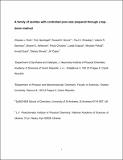Files in this item
A family of zeolites with controlled pore size prepared using a top-down method
Item metadata
| dc.contributor.author | Roth, Wieslaw J. | |
| dc.contributor.author | Nachtigall, Petr | |
| dc.contributor.author | Morris, Russell Edward | |
| dc.contributor.author | Wheatley, Paul Stewart | |
| dc.contributor.author | Seymour, Valerie Ruth | |
| dc.contributor.author | Ashbrook, Sharon Elizabeth | |
| dc.contributor.author | Chlubna, Pavla | |
| dc.contributor.author | Grajciar, Lukas | |
| dc.contributor.author | Polozij, Miroslav | |
| dc.contributor.author | Zukal, Arnost | |
| dc.contributor.author | Shvets, Oleksiy | |
| dc.contributor.author | Cejka, Jiri | |
| dc.date.accessioned | 2014-03-14T16:01:01Z | |
| dc.date.available | 2014-03-14T16:01:01Z | |
| dc.date.issued | 2013-07 | |
| dc.identifier | 71668313 | |
| dc.identifier | 623b10af-fd33-4890-84e5-8d31973b9024 | |
| dc.identifier | 000321042600017 | |
| dc.identifier | 84879363017 | |
| dc.identifier.citation | Roth , W J , Nachtigall , P , Morris , R E , Wheatley , P S , Seymour , V R , Ashbrook , S E , Chlubna , P , Grajciar , L , Polozij , M , Zukal , A , Shvets , O & Cejka , J 2013 , ' A family of zeolites with controlled pore size prepared using a top-down method ' , Nature Chemistry , vol. 5 , no. 7 , pp. 628-633 . https://doi.org/10.1038/NCHEM.1662 | en |
| dc.identifier.issn | 1755-4330 | |
| dc.identifier.other | ORCID: /0000-0002-4538-6782/work/56638954 | |
| dc.identifier.other | ORCID: /0000-0001-7809-0315/work/61622114 | |
| dc.identifier.uri | https://hdl.handle.net/10023/4529 | |
| dc.description.abstract | The properties of zeolites, and thus their suitability for different applications, are intimately connected with their structures. Synthesizing specific architectures is therefore important, but has remained challenging. Here we report a top-down strategy that involves the disassembly of a parent zeolite, UTL, and its reassembly into two zeolites with targeted topologies, IPC-2 and IPC-4. The three zeolites are closely related as they adopt the same layered structure, and they differ only in how the layers are connected. Choosing different linkers gives rise to different pore sizes, enabling the synthesis of materials with predetermined pore architectures. The structures of the resulting zeolites were characterized by interpreting the X-ray powder-diffraction patterns through models using computational methods; IPC-2 exhibits orthogonal 12- and ten-ring channels, and IPC-4 is a more complex zeolite that comprises orthogonal ten- and eight-ring channels. We describe how this method enables the preparation of functional materials and discuss its potential for targeting other new zeolites. | |
| dc.format.extent | 6 | |
| dc.format.extent | 209545 | |
| dc.language.iso | eng | |
| dc.relation.ispartof | Nature Chemistry | en |
| dc.subject | Structure-directing agent | en |
| dc.subject | Interlayer expansion | en |
| dc.subject | Channels | en |
| dc.subject | Framework | en |
| dc.subject | Layer | en |
| dc.subject | Transformation | en |
| dc.subject | Precursors | en |
| dc.subject | Silicates | en |
| dc.subject | Cations | en |
| dc.subject | System | en |
| dc.title | A family of zeolites with controlled pore size prepared using a top-down method | en |
| dc.type | Journal article | en |
| dc.contributor.sponsor | EPSRC | en |
| dc.contributor.sponsor | EPSRC | en |
| dc.contributor.sponsor | EPSRC | en |
| dc.contributor.institution | University of St Andrews. School of Chemistry | en |
| dc.contributor.institution | University of St Andrews. EaSTCHEM | en |
| dc.identifier.doi | 10.1038/NCHEM.1662 | |
| dc.description.status | Peer reviewed | en |
| dc.identifier.grantnumber | EP/K039210/1 | en |
| dc.identifier.grantnumber | EP/K025112/1 | en |
| dc.identifier.grantnumber | EP/K031252/1 | en |
This item appears in the following Collection(s)
Items in the St Andrews Research Repository are protected by copyright, with all rights reserved, unless otherwise indicated.

